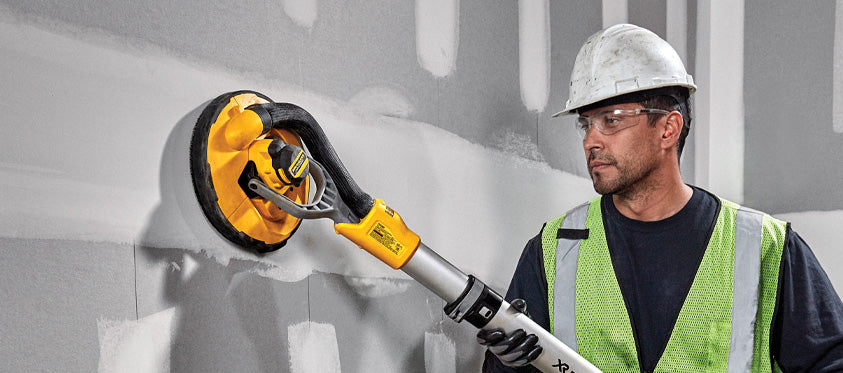When preparing for a sanding project, there are three major categories to consider: medium, grit, and coarseness. Let’s explore them together!
Medium
The options available to you on what to sand with are sanding paper, sanding sponges, and electric sanders. Sanding paper can be used alone, with a hand sander, or on a pole. Hand sanders are good for small jobs. Using a pole sander will give you better reach when dealing with high walls or ceilings. Apply medium pressure when using hand sanders and sanding sponges.
Sanding sponges are great for small areas and tight spaces. Sponges are more durable than sandpaper and will get into corners more easily than hand sanders - they won’t damage the opposite wall when sanding an inside corner either! This sanding option can be used wet or dry, is light weight, affordable, and easy to use.
Electric sanders are ideal in situations when you have a larger area to cover or are sanding more frequently. Orbital sanders and dust-free sanders are recommended. These will save a lot of elbow grease and hours. They are fast, precise, and give high-quality results. Light pressure is all you need with time savers!
Grit
When buying sandpaper the grit refers to the size of the grain. The higher the grit number the smaller the grain. The smaller the grain the finer the sandpaper.
Some common grit sizes include:
80-grit
100-grit
120-grit
150-grit
180-grit
220-grit
Coarseness
Coarseness refers to how fine the sandpaper is. Most sanding sponges will be described in terms of their coarseness rather than a specific grit number. Remember that:
Low grit number = large grain = coarse
High grit number = small grain = fine
When comparing coarseness and grit, a good range to keep in mind is:
Coarse: 80-100 grit
Medium: 120-150 grit
Fine: 180-220 grit
Extra Fine: 240 grit
When to Use What
As you apply coats of joint compound, start with coarser grits and end with finer ones. For example with the first coat and any rough uneven sections of joint compound, opt for a coarse to low-end medium grit (80-120). Second and subsequent coats can be sanded down with medium grits (120-150). Get a smooth, even finish with fine and extra fine grits (180-240) on finishing coats.
Now that you have the right grit, what do you put the sanding disc or paper on? Want more information on what sanding tools are available and their best applications? Read our blog on Sanding Drywall for Beginners.
With that, you’re ready to stock up and get sanding!
Find all your sanding needs including sanding paper, sanding sponges, and electric sanders at CSR Building Supplies!
Have a question? Don't hesitate to
CONTACT US
Call us Monday to Friday between 6 AM and 4 PM at (905) 761-5611
Email us anytime at info@csrbuilding.ca
Follow and share your work with us on Facebook, Instagram, and TikTok!
RESOURCES
https://www.h2ouse.org/what-grit-sandpaper-for-drywall/
https://homedecorbliss.com/what-grit-sandpaper-for-drywall/
https://www.nortonabrasives.com/en-us/resources/expertise/drywall-repair
https://peppershomeandgarden.com/grit-sandpaper-drywall-mud/







